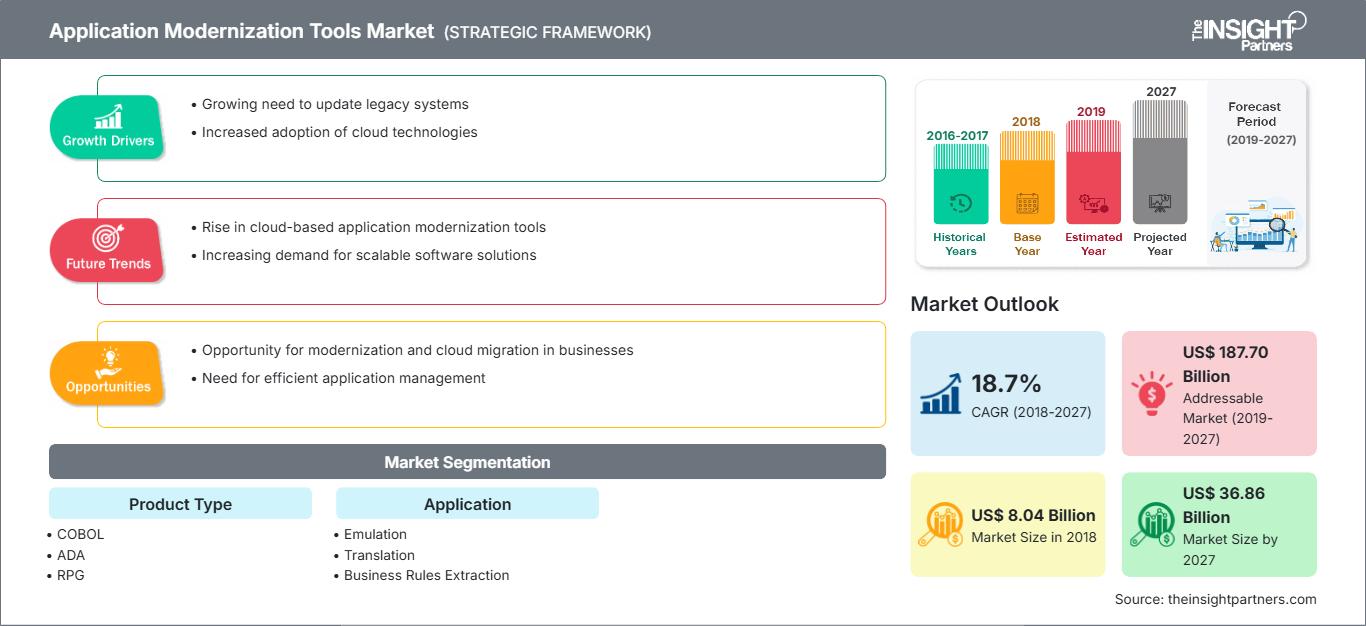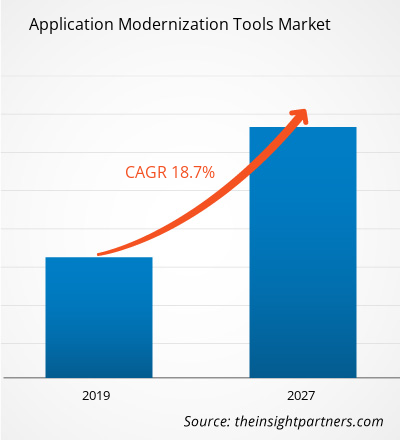Le marché mondial des outils de modernisation des applications représentait 8,04 milliards de dollars américains en 2018 et devrait croître à un TCAC de 18,7 % au cours de la période de prévision 2019-2027, pour atteindre 36,86 milliards de dollars américains d'ici 2027.
L'Amérique du Nord devrait détenir la plus grande part de marché des outils de modernisation des applications d'ici 2027. Les gouvernements maximisent leurs investissements numériques en exploitant stratégiquement les nouvelles technologies, ainsi que les données et les analyses avancées, pour optimiser les politiques et les programmes, et mettre à jour leurs systèmes existants. Améliorer et aligner les processus ; attirer de nouveaux investisseurs ; apporter une approche intelligente et axée sur les données dans les opérations gouvernementales ; fournir un meilleur accès à l'information et améliorer sa gestion ; renforcer la satisfaction et la confiance des citoyens ; transformer les services de transaction gouvernementaux ; Répondre aux besoins d'une démographie en constante évolution et équilibrer les coûts tout en optimisant l'efficacité jouent un rôle majeur dans la transformation informatique en cours dans les secteurs public, privé et gouvernemental.
Analyse du marché : La transformation numérique croissante dans tous les secteurs stimule la demande d'outils de modernisation des applications.
L'optimisation des processus métier de bout en bout, l'amélioration de l'efficacité opérationnelle, l'amélioration de l'expérience client et la réduction des coûts sont quelques-uns des facteurs qui stimulent le marché des outils de modernisation des applications. Le changement de paradigme des entreprises, passant des canaux traditionnels aux canaux numériques et automatisés, se traduit par de multiples avantages, allant de l'amélioration de l'efficacité à la réduction des coûts et à l'augmentation des opportunités de revenus, stimulant ainsi la croissance du marché des outils de modernisation des applications.
Personnalisez ce rapport en fonction de vos besoins
Vous bénéficierez d’une personnalisation sur n’importe quel rapport - gratuitement - y compris des parties de ce rapport, ou une analyse au niveau du pays, un pack de données Excel, ainsi que de profiter d’offres exceptionnelles et de réductions pour les start-ups et les universités
Marché des outils de modernisation des applications: Perspectives stratégiques

- Obtenez les principales tendances clés du marché de ce rapport.Cet échantillon GRATUIT comprendra une analyse de données, allant des tendances du marché aux estimations et prévisions.
Le haut degré d'intégration avec d'autres solutions offre une opportunité lucrative au marché des outils de modernisation des applications.
Vous bénéficierez d’une personnalisation sur n’importe quel rapport - gratuitement - y compris des parties de ce rapport, ou une analyse au niveau du pays, un pack de données Excel, ainsi que de profiter d’offres exceptionnelles et de réductions pour les start-ups et les universités
Marché des outils de modernisation des applications: Perspectives stratégiques

- Obtenez les principales tendances clés du marché de ce rapport.Cet échantillon GRATUIT comprendra une analyse de données, allant des tendances du marché aux estimations et prévisions.
Les acteurs du marché des outils de modernisation des applications intègrent diverses solutions aux applications et aux interfaces utilisateur sur tablettes, mobiles et web. Il s'agit d'un moyen économique et rapide de fournir de nouveaux processus métier à toutes les applications. Les fournisseurs de services intègrent des solutions telles que l'automatisation robotisée des processus (RPA), une plateforme d'automatisation en mode service. Elle permet de reproduire l'interaction entre la technologie et l'humain pour automatiser un large éventail d'opérations et de processus de support de manière rentable et augmente la fiabilité.
Informations sur les types de produits
Le marché mondial des outils de modernisation des applications, par type de produit, était dominé par le segment COBOL. Le processus de modernisation des applications est assez complexe avec les méthodes traditionnelles, mais avec l'adoption de technologies agiles, il est devenu plus simple et plus précis. COBOL est un langage de programmation de haut niveau qui génère des applications entièrement web et réorganise les projets dans les délais impartis, tout en respectant les normes et les spécifications pour une meilleure ergonomie, grâce à la modernisation des applications .NET et Java. Différentes plateformes disponibles sur le marché transforment les codes existants en langages avancés.
Informations sur les applications
En 2018, le marché mondial des outils de modernisation des applications était dominé par le segment de l'émulation. Ce segment devrait également détenir la plus grande part de marché d'ici 2027. L'émulation est un processus de réhébergement/re-plateforme de l'approche de modernisation utilisée pour fournir un environnement qui compile sur des plateformes distribuées en émulant l'environnement d'exploitation existant. La capacité d'émulation réduit le nombre de modifications et celles qui surviennent lors de la migration du système existant vers une plateforme distribuée. Le processus d'émulation offre la technique la plus rapide pour migrer les charges de travail d'un mainframe et constitue un moyen relativement peu coûteux et peu risqué de réduire les coûts d'exploitation tout en préservant la valeur commerciale. Ces facteurs devraient accroître la demande d'applications d'émulation sur le marché des outils de modernisation des applications.
Aperçu régional du marché des outils de modernisation des applications
Les tendances régionales et les facteurs influençant le marché des outils de modernisation des applications tout au long de la période de prévision ont été analysés en détail par les analystes de The Insight Partners. Cette section aborde également les segments de marché et la répartition géographique des outils de modernisation des applications en Amérique du Nord, en Europe, en Asie-Pacifique, au Moyen-Orient et en Afrique, ainsi qu'en Amérique du Sud et en Amérique centrale.
Portée du rapport sur le marché des outils de modernisation des applications
| Attribut de rapport | Détails |
|---|---|
| Taille du marché en 2018 | US$ 8.04 Billion |
| Taille du marché par 2027 | US$ 36.86 Billion |
| TCAC mondial (2018 - 2027) | 18.7% |
| Données historiques | 2016-2017 |
| Période de prévision | 2019-2027 |
| Segments couverts |
By Type de produit
|
| Régions et pays couverts | Amérique du Nord
|
| Leaders du marché et profils d'entreprises clés |
|
Densité des acteurs du marché des outils de modernisation des applications : comprendre son impact sur la dynamique des entreprises
Le marché des outils de modernisation des applications connaît une croissance rapide, porté par une demande croissante des utilisateurs finaux, due à des facteurs tels que l'évolution des préférences des consommateurs, les avancées technologiques et une meilleure connaissance des avantages du produit. Face à cette demande croissante, les entreprises élargissent leur offre, innovent pour répondre aux besoins des consommateurs et capitalisent sur les nouvelles tendances, ce qui alimente la croissance du marché.

- Obtenez le Marché des outils de modernisation des applications Aperçu des principaux acteurs clés
- Analyse historique (2 ans), année de base, prévision (7 ans) avec TCAC
- Analyse PEST et SWOT
- Taille du marché Valeur / Volume - Mondial, Régional, Pays
- Industrie et paysage concurrentiel
- Ensemble de données Excel
Rapports récents
Témoignages
Raison d'acheter
- Prise de décision éclairée
- Compréhension de la dynamique du marché
- Analyse concurrentielle
- Connaissances clients
- Prévisions de marché
- Atténuation des risques
- Planification stratégique
- Justification des investissements
- Identification des marchés émergents
- Amélioration des stratégies marketing
- Amélioration de l'efficacité opérationnelle
- Alignement sur les tendances réglementaires




















 Obtenez un échantillon gratuit pour - Marché des outils de modernisation des applications
Obtenez un échantillon gratuit pour - Marché des outils de modernisation des applications